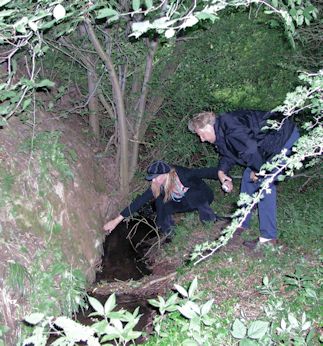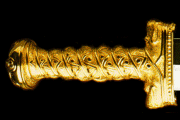Page 12 of 12
The Templars and the Ark of the Covenant
Written in Stone

Jodi and Graham Russell examine the stream bank where the stone slab was found.

The inscribed stone slab found near Chapel Green. (Click on imager for larger picture.)
The area around the water fountain was later surveyed by archaeologists using geophysics equipment to detect what was under the ground. Unfortunately, nothing of interest was found. However, it was ultimately discovered that the 1940s the entire area around the fountain was dug up to widen the lane and to build a number of houses along the new road. The records showed that the excavated rubble had been used to divert a stream in a nearby wood and this area too was investigated by the geophysics team. Although there was no evidence of any gold objects like the Ark of the Covenant, one thing was found that must have originally come from the ground excavated beside the water fountain. In the banks of the stream, a flat stone slab was discovered which was about an inch thick, a foot and a half long, and a foot wide. Made of sandstone, it was inscribed with what appeared to be thirteen separate symbols, cut into the stone to a depth of about a quarter of an inch. The slab had clearly been broken off from a longer piece as the one end was irregular and jagged. The other end, however, was smoother and had been deliberately rounded at the corners.
Gustave Doré’s Moses with the Ten Commandments.
If the Templars treasures had been hidden in Chapel Green they had long since been removed, either by Jacob Cove-Jones or someone else. The stone slab, however, may have been overlooked. It is just possible that it may have been the most important artifact of all. The sandstone from which it was cut was identified as arenite sandstone – precisely the same sort of rock from which Jebel Madhbah is formed. If Graham was right this was the true Mount Sinai, and the Book of Exodus states that the stone slabs from which the Ten Commandments were made came from that very mountain (Exodus 34:4). Could this stone slab have been one, or part of one of the two tablets that the Bible says were inscribed by God, given to Moses and kept in the Ark of the Covenant?
The slab was taken to the British Museum in London, which boasts England’s best facilities for identifying ancient artifacts. However, as the stone was not made from organic matter it could not be carbon dated, and as it had been removed from its original location and used for landfill its age could not be determined by the usual archaeological methods. How long ago the slab was shaped and inscribed was also a mystery as the symbols carved into it could not be identified. They appeared to match no form of ancient or modern writing. In fact, they could not be matched with any known alphabet or symbol system on the museum’s massive database.
In The Templars and the Ark of the Covenant, Graham Phillips and Jodi and Graham Russell go in search of the lost Ark and the treasures once said to have been housed in the Temple of Solomon. Further clues discovered in the Epiphany Widow lead to other remarkable discoveries and an incredible adventure that must be one of the most astonishing real-life stories ever told.









